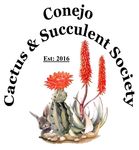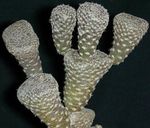Meetings at Last! Monday, October 4th - Conejo Cactus ...
←
→
Page content transcription
If your browser does not render page correctly, please read the page content below
Succulent Scoop
Conejo Cactus & Succulent Society
October 2021 Volume 6 Number 10
Mission Statement:
The Conejo Cactus And Succulent Society encourages the study,
CSSA Affiliate cultivation, conservation, and appreciation of cacti and other succulent plants.
Email: ConejoCSS@hotmail.com Facebook: Conejo Cactus & Succulent Society Web: ConejoCSS.com
Meetings at Last!
Monday, October 4th
New Meeting Location
California Lutheran University
Lundering Events Center
130 Overton Court,
Thousand Oaks, CA 93021
Doors Open at 6:30
PROGRAM: Thailand: An Unexpected Succulent Paradise
Dr. Kyle Williams
Most people know Thailand as a Asian country with nice beaches and lots of
Buddhist temples. What most people do not realize is that there is a very large
community of cactus & succulent enthusiasts that grow rare desert plants in a
tropical rainforest climate. Kyle will give a photographic tour of Thailand cover-
ing not only the cacti and succulents grown in Thailand but other botanical wonders as well.
Dr. Kyle Williams became fascinated with plants as a teenager. He attended college at Cal
Poly, San Luis Obispo where he gained a B.S. degree in Ornamental Horticulture. That in turn
sparked an interest in botany that saw him earn a PhD from Duke University in Plant Taxon-
omy. Eventually Kyle decided to leave the academic world behind and start his nursery,
Kyle’s Plants, which specializes in cacti & succulents.President’s Message:
The Succulent Scoop is short this month. Our editor, Melinda Hines, has the opportunity to go on a
road trip and timing was too short to do a newsletter with all the photos.
Most of the emphasis this month will be put on our ‘New Beginning’. Our first in-person meeting
in a year and a half, in a brand new meeting location, and our October sale which also has a new
location.
We will have plant of the month judging! So bring your Opuntia or Aizoaceae (Mesembs Mesembryanthemaceae)
along to the meeting. See Page 4 for Plant of the Month rules.
The November newsletter will return to its old format. There will only be photos of the Plants of the Month that
were presented at the monthly meetings. We need a volunteer to take the photos because Melinda is
“handicapped” in that department. Also, if you have any succulent/cactus related info, stories, poems, trivia or
cartoons you’d like to share with members, send it to Melinda ( Loper987@yahoo.com ) for possible inclusion in
the Succulent Scoop.
For those of you who may still be uncomfortable in a live meeting situation we are going to try and offer a Zoom
presentation along with our in-person presentation. The new equipment we have in our new facility allows us to do
both, providing we can figure out how to use it. The College assures us that they have technical people available
to us at all times, if need be. The Zoom portion of our meeting will only be for Kyle’s presentation, not the whole
meeting.
As far as refreshments go, we will not start using the alphabet as to who brings the refreshments until January.
Anyone who wants to bring refreshments is welcome, but everything must be prepackaged, nothing open or
homemade. We will provide water and coffee.
Our sale, on Oct. 17th is coming up very quickly. If you have any plants you wish to donate, please bring them with
you to the sale.
We will need to wear a mask at both the meeting and the sale. Ventura County has mandated that masks must be
worn in indoor settings until October 19th. The club is requiring that all people wear masks at our sale.
We still need 9 more volunteers, mostly for afternoon time slots. Please call me at (805) 501-0761 to volunteer.
We are doing a lot more advertising than in the past, and we have more vendors than ever before, so it should be
our best sale yet and we’ll need as many of you who can volunteer to handle the possible crowds.
Check out our new club flyer on Page 3. If you are able to post them in prominent locations, it will help to get the
word out about our club.
I’m looking forward to seeing everyone in person again on October 4th.
Linda Holub
President CCSS
CCSS 2021 Officers
President Treasurer Director II, Education Website
Linda Holub Julie Myers Terry Wilson Tim Alvord
1st VP, Programs Secretary Scoop Editor Librarian
Ann Hopkinson Valerie Fox Melinda Hines Glen Smith
2nd VP, POM & Director I, Membership Hospitality Plant Propagation
Education Glen Smith Lisa Gailey and Terry Wilson
Kyle Williams Assistant to Director I Pam Smith Event Publicity
3rd VP, Special Events Pam Smith, Membership Drawing Coordinator Donna Pachorek
Donna Pachorek Gerry Caruso
CCSS Mailing Address: 530 Los Angeles Ave. Ste #115-183, Moorpark, CA 93021
October 2021 Page 22021 CCSS Plants of the Month
Month Cactus Succulent
January Copiapoa Crassulaceae
February Echinopsis Aloe
March Mammillaria Aeonium
April Gymnocalycium Pelargonium & Sarcocaulon
May Melocactus & Discocactus Haworthia
June Miniatures Miniatures
July Astrophytum Terrestrial Bromeliads
August Ariocarpus & Obregonia Euphorbia
September Variegated Variegated
October Opuntia Mesembs*
November Epiphytic cacti Agave
December Favorites Favorites
*See Kyle’s Succulent POM article on Page 6 for what’s included in the Mesembs category
Plant of the Month (POM) What is this all about?
Each meeting of the CCSS will feature a friendly plant show/competition (POM). The goal of the
POM is two fold.
Introduce the membership to the various cactus and succulent genera and to open up a
discussion on the culture, care, and display of these plants.
Encourage members to share their plants with membership.
POM Submissions:
Members may submit up to 3 three plants in each of the two categories (Cactus and
Succulents). Plants entered in the Intermediate and Advanced Divisions must have been
owned and maintained by the member for a minimum of one year. Plants entered in the
Novice category may be newly acquired plants.
POM Divisions:
Novice: 0-25 Total points ● Intermediate: 26-100 Total points ● Advanced: >100 Total
Points
When a member has accumulated the total number points in their Division, they will be moved
up to the next higher Division in the following calendar year.
POM Judging Criteria:
Plants are evaluated according to the following criteria:
Condition (health, form, damage). 50%
Maturity and size. 25%
Staging (Artistic composition - container, stonework, etc). 20%
Nomenclature (proper plant identification). 5%
Additional criteria may include rarity, difficulty in growing, and whether the plant is in flower.
POM Judging:
1st place - 6 points ● 2nd place - 3 points ● 3rd place - 2 points
All other entries will be awarded 1 point. Entry slips will be collected by the POM Coordinator
for tabulation, record keeping, and publication in the CCSS Newsletter.
We are encouraging all members to participate in the POM. This is your opportunity to show off
your prized treasures or to possibly learn how to better care for your plants.
See you at the next meeting
CCSS Board
October 2021 Page 4Cactus of the Month: Opuntia and Close Relatives
Opuntia is one of the largest genera of the Cactaceae (cactus family) and is the most
common type of cactus in North America. Plants in this genus form jointed stems that
to many look like leaves (but aren't). The most distinctive (and reviled) feature of
Opuntia are "glochids", tiny-hair like spines that stick in your skin even if you just brush
against the plant lightly. Always have tweezers ready when Opuntia are near! Jointed
stems and glochids are found in most of the Opuntioidiae, which consists of Opuntia
and several closely related genera (see below).
For the sake of the "Plant of the Month" we will include Opuntia and its close relatives.
This includes Austrocylindropuntia, Cumulopuntia, Pereskiopsis, Quiabentia, Brasi-
lopuntia, Miqueliopuntia, Tacinga, Tunilla, Pterocactus, Puna, Maihuniopsis, and
Tephrocactus, and the Chollas (Cylindropuntia).
Opuntia (in the broad sense) covers the largest
geographical range of any cactus, stretching from
Southern Argentina to Canada, and covers all of the
Caribbean islands and Pacific Islands from the
Galapagos to the Catalinas. It is naturalized on
every continent except Antarctica. It is a pest and
a noxious weed in many places, and is displacing
native vegetation in parts of Africa, Asia, Madagas- Opuntia ‘Sunburst’
car and Australia. Variegated
The taxonomy of Opuntia is quite complex and is bound to keep plant taxono-
mists busy for years to come! Some of the genera I mentioned above are
widely accepted while others are accepted by some and others consider them
Tephrocactus geometricus part of a larger Opuntia. Most of the recent changes in the Opuntia group is
due to recent DNA phylogeny studies of the species.
Propagation of all Opuntias is most easily accomplished by cuttings.
All cuttings root easily. Seed propagation requires patience, with seed
scarification and sometimes artificial wintering by keeping the seed
damp and cold in the refrigerator required. Seed germination can be
erratic, with seeds from the same plant sometimes germinating in days,
and sometimes not for months or years.
Handling of Opuntias is somewhat of a problem due to their glochids.
Handling with steel tools is the best bet. Gloves get covered with
glochids, which invariably end up in your hands when the gloves come
off. Glochids can often be removed by washing with a strong hose
stream. Plucking with tweezers is the most effective, especially if you
use a good magnifying glass. Other options include brushing, duct tape
and rubber cement.
Puna clavarioides
Kyle Williams
Photo Credits: Kyle Williams
October 2021 Page 5Succulent of the Month: Aizoaceae (Mesembryanthemaceae)
or informally Mesembs
Mesembryanthemaceae is one of the longest and ugliest plant family names.
Thankfully, botanists don't call it that anymore. Now we refer to the family as
the Aizoaceae. You can informally call them Mesembs as well. The change in
name is due in part to the uniting of plants formally in different families. The
Aizoaceae contains over 130 genera and nearly 2000 species, making it as big
or bigger than the Cactaceae. Most Aizoaceae are fleshy and succulent plants.
While most species that we grow are very highly succulent, such as Lithops,
Faucaria, or Ice Plant (Carpobrotus), some genera are just slightly succulent
and more resemble a typical herb.
Aizoaceae have a worldwide distribution in arid regions, including two species
native to California. Despite the family technically being worldwide, the over-
whelming number of genera and species (96%) come from southern Africa. It Faucaria tuberculosa ‘Sato’
is interesting to compare the Cactaceae with the Aizoaceae in that both families
have developed extreme succulence in order to survive their arid habitats. However, how they went about it
shows that evolution can converge on a basic idea in two different ways. Cacti have evolved thick fleshy stems
that store water during lean times while also getting rid of big green leaves (except in Pereskia and a few other
species) that lose a lot of water on hot days. The leaves of a cactus have been turned into the spines that
protect the plant from predators. The Aizoaceae took a different path. The stems have been nearly lost in
many species (e.g. Lithops), or tend to be fairly thin and not much for water storage. The leaves have become
extremely fleshy to the point where they are practically balloons filled with
water. Whereas Cacti "fight" their predators by forming big sharp spines,
the small stemless Aizoaceae hide from them by blending into their
surroundings. They in essence become indistinguishable from rocks and
are therefore ignored by thirsty predators. Another strategy employed by
many Aizoaceae is to grow in the cracks of rocks. That gets them away
from bigger, faster growing shrubs and grasses that would shade them
out, but also helps them survive against predators. If a thirsty animal were
to find one of these in the ground they could eat the whole thing killing it. If
they find one wedged in a rock they might be able to eat the exposed leaves
Conophytum obcordellum but the base of the plant would be protected, allowing the plant to regrow.
Our climate is great for growing most Mesembs, though, with nearly 2000 species,
general advice for growing all of them is impossible to give. However, for the
fleshy leaved South African species basic advice can be given. First of all, you
need to know if your plant comes from the winter rainfall regions (which is very
similar to our own climate) or from summer rainfall regions. For winter growers
such as Conophytum, Cheiridopsis, or Fenestraria you can embrace our climate
by letting the winter rains water them from fall through spring and then keeping
them totally dry (or nearly so) during the summer. For summer growers like
Faucaria, Pleiospilos, or Lithops relatives like Argyroderma and Tanquana keep
them totally dry in the winter and water in the summer, except when it is very hot
out at which time they should be kept dry again. With few exceptions no Mesemb
wants to be wet for any length of time. So if our winters are especially rainy even Titanopsis hugoschlecteri
the winter growers might need some protection. Similarly, don't soak your summer
growers too often even during the growing season. Please realize that summer and winter growers may
vary within a genus. For example, Titanopsis calcarea is a summer grower while T. hugoschlecteri is a winter
grower. The plants don't care what genus they are, they care about the climate where they live in nature.
When in doubt look it up!
Kyle Williams
Photo credits: Kyle Williams
October 2021 Page 6Succulent & Cactus Plant Sale
Sunday, October 17, 2021
9:00 am - 4:00 pm
558 North Ventu Park Road
Thousand Oaks, CA, 91320
SE corner of Ventu & Hillcrest
Vendors will be offering
Cactus, Succulents, Bromeliads & Plumerias
Along with Pottery
and Jewelry
Experts will be available for
advice on growing and cultivation
Please bring boxes or bags to carry home your purchases.
For more information: Facebook: Conejo Cactus & Succulent Society
Web: ConejoCSS.com Email: ConejoCSS@hotmail.com
October 2021 Page 7You can also read



























































